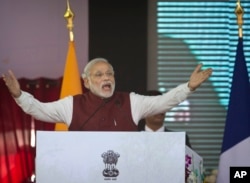In Sri City, an industrial park in India’s southern state of Andhra Pradesh that houses several Chinese factories, Chinese company Xi’an LONGi is investing $225 million to set up a facility to make solar cells and components.
One of the world’s largest solar equipment manufacturers, LONGi is among a growing number of Chinese firms, such as Lenovo, Gionee, Vivo and Xiaomi, that have rolled out production facilities in India over the last year.
Ravindra Sannareddy, managing director of Sri City, said a large domestic market and lower wages are attracting these companies.
“They see that Indian consumption is going up, so they want to put factories in India, and also some of the people are coming to India to make in India and export because wage levels in China are going up,” according to Sannareddy.
The hourly labor cost for manufacturing in India is less than half that of China, attracting industries that are labor intensive, such as toy-maker Pals Plush, one of the Chinese units in Sri City.
Ranked by the World Bank as one of the most difficult places to do business, global firms had long bypassed India as a manufacturing base.
But Prime Minister Narendra Modi has been encouraging foreign investors, including the Chinese, to take another look at the country of 1.2 billion people under a campaign billed ‘Made in India.’
Industrial hub
Modi has ambitions to turn India into a global industrial hub to create millions of jobs needed for its young population – about one-half of India's population is under the age of 25. Those efforts are starting to yield some results.
Pankaj Mahindroo, who heads the Indian Cellular Association, expects Chinese mobile handset manufacturers to invest about $2 to $3 billion in the next two to three years to assemble phones in India and create more than 100,000 jobs.
The Chinese mobile phone companies are attracted by projections that India will be the world’s second largest smart phone market by 2017.
Besides the huge market and lower wages, the country’s skilled labor pool is a big draw for manufacturers. “Software manpower is very, very good and people in design and testing are also extremely good,” said Mahindroo.
However, economists warn that while India has made a start, ambitions of becoming an industrial hub could elude the country without more reforms and attention to its biggest drawback -- the country’s shoddy infrastructure. Over the last year, government efforts to usher in labor and land reforms have been stalled by an aggressive opposition.
Projects to expand transport networks are proceeding slowly. No one knows that better than Sannareddy, who established the Sri City industrial park close to Chennai port to give businesses easy connectivity. But he admits that hurdles remain.
“We are expanding our ports, but still it is not like the cargo, if you send it today, it can go. There is congestion in some of the ports. And airport international connectivity can be improved, power situation still needs improvement. Sometimes we can debate whether the speed at which they are changing is ripe for more manufacturing to come or not,” he cautioned.
Still, overall optimism about India, now the world’s fastest-growing major economy, is keeping investments flowing. Last week, Chinese real estate developer Wang Jianlin announced plans to invest up to $10 billion to develop in an industrial township in Haryana state in the north.









